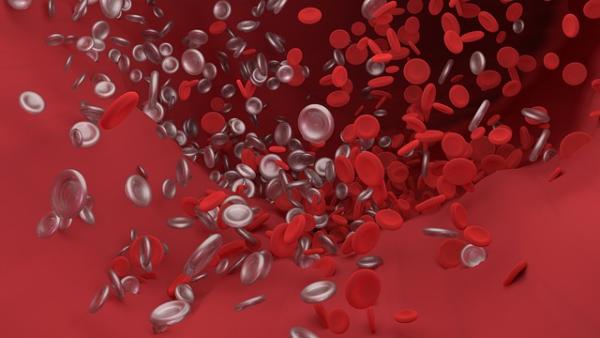Background knowledge
When our circulatory system is injured, we form clots to stop the leak and begin repair. It is a complex process involving platelets, small cellular-like elements in our blood, that provide a scaffold. At the same time, various coagulation factors interact to lay down a fine mesh of fibrin, to fill the scaffolding in, signaling an injury requiring assistance in repair. Vascular surgeons have a love-hate relationship with clotting. On the one hand, it helps fill the tiny holes our sutures leave in the artery, on the other hand, when our work is sub-optimal, it causes the repair to thrombose, another word for a clot causing the circulation to stop in that area.
We form tiny clots all the time, and our body has evolved to remove them with a system that dissolves those platelet plugs and fibrin mesh. The lung, which serves as a kind of filter for this "debris" has lots of fibrinolytic, the factors for dissolving now-unnecessary clots.
Sepsis, an overwhelming infection, bacterial or viral, affects 1.7 million Americans annually, even before COVID-19, and is a – if not the leading – cause of death in the hospital. [1] A frequent complication of sepsis, occurring in 30-50% of cases, is disseminated intravascular coagulation or DIC. The term describes a process in which the balance between clotting and clot-dissolving is out of balance, with many tiny clots being formed, using up all the necessary platelets, fibrin and clotting factors, and ending, perhaps paradoxically, in bleeding. Several viruses, including the very scary Ebola virus, are known to cause DIC. There is an increasing concern, along with a bit of evidence that DIC may also be in COVID-19's bag of tricks.
Clotting and COVID-19
The telltale signs of DIC in sepsis come from tests of the coagulation system, showing fewer platelets, thrombocytopenia is the term, an increase in fibrinogen, the precursor to fibrin, and D-dimer, a product that forms when fibrin is broken down. All are signs that clotting factors are being used up. In COVID-19, platelet levels remain relatively normal, and the usual scoring systems for identifying DIC remains stubbornly "normal" over 90% of the time, an unfortunate false negative. Other clotting factors show alterations too, prompting this statement about the laboratory presentation, phenotype, of COVID-19's pro-clotting, thrombotic, state.
"Our patients with COVID-19 had no such phenotype but were highly thrombotic without evidence of DIC. Moreover, this phenotype is also different from that of patients admitted in ICU with ARDS due to bacterial pneumonia and might be a specific presentation of COVID-19."
These researchers looked at 150 consecutive ICU admissions with proven [2] COVID-19 infections. 11.7% of these patients developed clots, most often from clots that formed in the legs and traveled to the lungs, termed pulmonary emboli, further impairing the lungs' ability to absorb oxygen and release carbon dioxide. Matched patients with non-COVID acute respiratory distress syndrome, ARDS had a 4.8% incidence of DIC. The clotting associated with COVID-19 was similar, but not the same, prompting researchers to speculate that the underlying cause of clotting disorders in COVID-19 infections is different.
Why?
Short answer: no one knows; it is called a novel virus for a reason and we are just gaining clinical experience with COVID-19 now. That said, there is an interesting hypothesis. We know that the angiotensin-converting enzyme (ACE) receptors are the virus's entry point into our bodies. These ACE receptors are found throughout the lining of the lung, interestingly enough at elevated numbers in smokers. Still, they are also found in the cells lining the blood vessels, termed endothelium, as well as in cells in the heart. The thought is that once the virus multiplies and enters the bloodstream, it goes on to attack these other ACE receptors – causing an inflammatory response by the endothelium, endotheliitis, and the heart cells, myocarditis.
The inflammation and infection of the lining of the lungs could alter the ability of the lung to act as a filter in removing small clots and fibrin. As a result, the alveoli, that portion of the lung responsible for absorbing the oxygen that we breathe, is thickened, making for an increasing inability to extract oxygen and ultimately requiring supplemental oxygen or mechanical ventilation.
Usually, when an area in the lung is not well ventilated, blood vessels constrict, shunting blood away from those areas to maintain a good match between our ability to extract oxygen and then deliver it throughout the body. Endotheliitis could compromise the ability of the blood vessels to constrict, increasing the mismatch. It could well explain the autopsy findings of many tiny blood vessels being filled with clots. And many clotted little blood vessel results in larger and larger vessels clotting and explains the higher incidence of thrombotic events like pulmonary embolism.
Finally, an infection by COVID-19 of those heart cells resulting in myositis may well explain the increasing number of patients with abnormal heart rhythms and damage to the heart muscle. This may worsen the outcome in patients who already have underlying heart disease, one of COVID's acknowledged risk factors.
There are other theories of COVID-19's thrombotic behavior, including a belief that the degree of cellular destruction uncovers portions of the cell membrane that are, by themselves, thrombogenic, clot forming. It is just too early to know. The data is only now being gathered, and the urgency to get ahead of this disease makes it easier to skimp on methodology and produce numbers. I am a clinician; I get it. When all around you are dying, you have to do something. There is no ill intent in the communications but think of these reports as pilot studies, with very tentative conclusions.
Reliable understanding COVID-19 is going to take more time, not for want of trying, but because it requires accumulated experience.
[1] Sepsis Fact Sheet, Sepsis Alliance
[2] Nucleic acid amplification testing of specimens
Source: High risk of thrombosis in patients in severe SARS-CoV-2 infection: a multicenter prospective cohort study. Intensive Care Medicine DOI: 10.1007/s00134-020-06062-x




